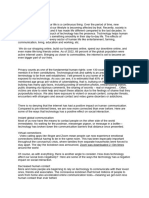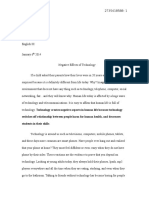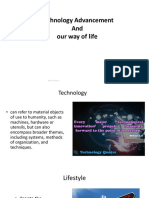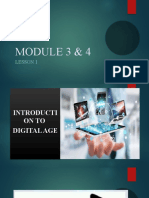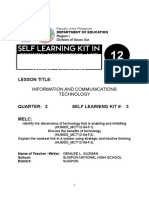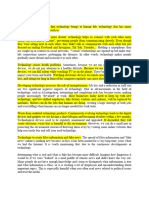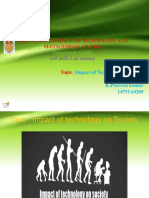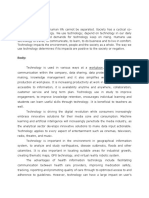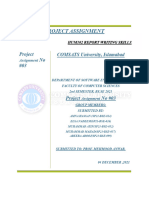MODULE LIVING IN THE IT ERA – IT01
CHAPTER 4: SOCIAL IMPLICATIONS OF ICT
IN THE SOCIETY
Objectives:
a) Discuss the social implications of ICT in the society.
b) Identify the negative effects of technology to the society.
c) Discover the how ICT is developing social businesses.
Lesson 1: The social impact of ICT
Information communications technology
(ICT) has the power to transform society. It plays
a key role in each of the United Nations’
Sustainable Development Goals, providing the
infrastructure needed to achieve them. It also
enables financial inclusion through m-
commerce and allows people to connect with
millions instantaneously.
The impact of ICT on business is particularly significant. It empowers people to share knowledge
and advice instantaneously and set up an online shop or website at a low cost, dramatically
lowering the barriers to starting a business. As such, it is an important enabler of change and ICT
maturity is closely linked to economic growth.
Advances in technology have always been used by for-profits to increase revenue. However,
government bodies and NGOs have struggled to successfully apply them for social good. An
emerging type of business, the social business, is bridging the gap between the two.
Technology Has Made Our Lives Far Easier and Better Through Better Communication
The role of technology has successfully made the communication aspect much easier and
better for us humans. Earlier, (a couple of decades ago) we had to wait for the message for days
and even, in some cases, for months.
And we can drastically see the change which has taken place.
Page | 1
� MODULE LIVING IN THE IT ERA – IT01
Now, all it takes is a few clicks of our fingers on the smartphones to send out a mail, message to
our loved ones or office colleagues. The user experience and interface have drastically improved
with the upcoming modern age technology.
With Technology Advertising Has Been Made Easier
Technology has not left a single aspect of our lives which it has not touched. And one such aspect
is that of the advertisement. Nowadays, owing to the rise of digital technology and online
marketing, advertising has become way easier and comfortable then it was before.
Some examples would be Facebook marketing, Google Ads.
Amazing Change in Travel Industry
The travel industry has been impacted by technology in a very huge way. There are Google Maps,
Google Earth and so on which the user can operate and use as per their convenience. And
moreover, there have been new and upcoming business models in the travel sector such as car
rentals where a person can hire a luxury car or a mid-level car according to their needs. Overall,
we can say that things are becoming more and more interesting.
Technology Has Made Learning Easier and Efficient
There is no doubt in the fact that with the surge on the internet over the last couple of years, it
has become very easy for people to rummage the internet and get the necessary information.
And owing to this, learning and grabbing new information regarding any subject has become way
easier which is good for the geeks.
Role of Technology in Data Storing
A couple of decades ago retrieving data was a very tough process to deal with as people had to
scour various files and specifically hand-pick the file by narrowing it down.
But now, it is not like that at all. Nowadays, all you need to do is save it on your computer, tablet,
and even smartphones.
And whenever, you need, you can search for the specific file and within seconds it will be in your
hands. Not just it is time-saving but also has made our lives significantly easy.
For more knowledge about the social impact of ICT, please check the link provided:
https://www.youtube.com/watch?v=JFabyFx5dWw&ab_channel=TeacherJessebelTe
ves
Page | 2
� MODULE LIVING IN THE IT ERA – IT01
Lesson 2: Negative effects of technology
People are more connected than ever, thanks in large part to rapid advancements in
technology. While some forms of technology may have made positive changes in the world, there
is evidence for the negative effects of technology and its overuse, as well.
Social media and mobile devices may lead to psychological and physical issues, such as
eyestrain and difficulty focusing on important tasks. They may also contribute to more serious
health conditions, such as depression. The overuse of technology may have a more significant
impact on developing children and teenagers.
Psychological effects
Overuse or dependence on technology may have adverse psychological effects, including:
Isolation
Technologies, such as social media, are designed to bring people together, yet they may have the
opposite effect in some cases.
A 2017study in young adults aged 19–32 years found that people with higher social media use
were more than three times as likely to feel socially isolated than those who did not use social
media as often.
Finding ways to reduce social media use, such as setting time limits for social apps, may help
reduce feelings of isolation in some people.
Depression and anxiety
The authors of a 2016 systematic review discussed the link between social networks and mental
health issues, such as depression and anxiety.
Their research found mixed results. People who had more positive interactions and social support
on these platforms appeared to have lower levels of depression and anxiety.
However, the reverse was also true. People who perceived that they had more negative social
interactions online and who were more prone to social comparison experienced higher levels of
depression and anxiety.
So, while there does appear to be a link between social media and mental health, a significant
determining factor is the types of interactions people feel they are having on these platforms.
Physical health effects
Technology use may increase the risk of physical issues as well, including:
Eyestrain
Page | 3
� MODULE LIVING IN THE IT ERA – IT01
Technologies, such as handheld tablets, smartphones, and computers, can hold a person’s
attention for long periods. This may lead to eyestrain.
Symptoms of digital eyestrain can include blurred vision and dry eyes. Eyestrain may also lead to
pains in other areas of the body, such as the head, neck, or shoulders.
Several technological factors may lead to eyestrain, such as:
• screen time
• screen glare
• screen brightness
• viewing too close or too far away
• poor sitting posture
• underlying vision issues
Taking regular breaks away from the screen may reduce the likelihood of eyestrain.
Anyone regularly experiencing these symptoms should see an optometrist for a checkup.
The 20-20-20 rule for digital viewing
When using any form of digital screen for longer periods of time, the American Optometric
Association recommend using the 20-20-20 rule.
To use the rule, after every 20 minutes of screen time, take a 20-second break to look at
something at least 20 feet away.
Doing this may help reduce the strain on the eyes from staring at a screen for a continuous period.
Poor posture
The way many people use mobile devices and computers may also contribute to incorrect
posture. Over time, this may lead to musculoskeletal issues.
Many technologies promote a “down and forward” user position, meaning the person is hunched
forward and looking down at the screen. This can put an unnecessary amount of pressure on the
neck and spine.
A 5-year study in the journal Applied Ergonomics found an association between texting on a
mobile phone and neck or upper back pain in young adults.
The results indicated the effects were mostly short term, though some people continued to have
long-term symptoms.
However, some studies challenge these results.
A 2018 study in the European Spine Journal found that the posture of the neck while texting
made no difference in symptoms such as neck pain.
Page | 4
� MODULE LIVING IN THE IT ERA – IT01
This study concluded that texting and “text neck” did not influence neck pain in young adults.
However, the study did not include a long-term follow-up.
It may be that other factors influence neck pain, as well, such as age and activity levels.
Correcting posture problems while using technology may lead to an overall improvement in
posture and strength in the core, neck, and back.
For example, if a person finds themselves sitting in the same position for hours at a time, such as
sitting at a desk while working, regularly standing or stretching may help reduce strain on the
body.
Additionally, taking short breaks, such as walking around the office every hour, may also help
keep the muscles loose and avoid tension and incorrect posture.
Sleep problems
Using technology too close to bedtime may cause issues with sleep. This effect has to do with the
fact that blue light, such as the light from cell phones, e-readers, and computers, stimulates the
brain.
Authors of a 2014 study found that this blue light is enough to disturb the body’s natural circadian
rhythm. This disturbance could make it harder to fall asleep or lead to a person feeling less alert
the next day.
To avoid the potential impact of blue light on the brain, people can stop using electronic devices
that emit blue light in the hour or two before bedtime.
Gentle activities to wind down with instead, such as reading a book, doing gentle stretches, or
taking a bath, are alternatives.
Reduced physical activity
Most everyday digital technologies are sedentary. More extended use of these technologies
promotes a more sedentary lifestyle, which is known to have negative health effects, such as
contributing to:
• obesity
• cardiovascular disease
• type 2 diabetes
• premature death
Finding ways to take breaks from sedentary technologies may help promote a more active
lifestyle.
Other forms of technology may help, however.
Page | 5
� MODULE LIVING IN THE IT ERA – IT01
Research from 2017 indicates that active technologies, such as app notifications, emails, and
wearable technologies that promote exercise may reduce short-term sedentary behavior.
This could help people set healthful patterns and become more physically active.
For more knowledge about negative effects of technology, please check the link
provided;
https://www.youtube.com/watch?v=qUO4Bsv8tYA&ab_channel=TaylorHofstrandBu
nn
Lesson 3: ICT and the social business
Social businesses are driven by a social cause, but seek financial stability in order to
further their impact. ICT is playing a central role in the emergence and development of social
businesses. These companies are driven by a social cause, but seek financial stability through
profit making in order to further their impact. This combination is allowing them to effectively
utilize technology for good.
The impact of ICT infrastructure on social businesses cannot be understated. It has made social
impact affordable, social impact scalable, and enables new ways to connect to and engage with
local communities (a key characteristic of the social business).
ICT is developing social businesses in three main ways:
Affordability
Starting any business can be financially challenging. But for social entrepreneurs, whose
primary intent is to engage with local communities rather than to make profit, it can be
particularly daunting. In the initial stages, it can also be difficult to convince investors to part with
their money for a social cause.
ICT solutions have decreased set-up costs in an unprecedented way. This helps social
entrepreneurs to make it through this uncertain period without major investments or losses –
and advice is only the click of a button away.
Scalability
ICT infrastructure allows us to connect instantaneously with millions. For social
entrepreneurs, this means that their initiatives aren’t just limited to one community; they can
easily reach the people they want to empower and spread their message far and wide.
Many social businesses also utilize ICT solutions to optimize processes, reduce costs and increase
accuracy, enabling the business to be scaled up faster. For example, Sanergy in Nairobi, Kenya,
uses radiofrequency identification sensors to alert the waste team to when a toilet needs to be
Page | 6
� MODULE LIVING IN THE IT ERA – IT01
emptied. SiembraViva in Medellín, Colombia, is developing solutions that will allow them to
monitor harvests remotely and alert farmers to problems quickly.
Community
To ensure lasting empowerment, social businesses work from within the community. As
previously highlighted, ICT allows social entrepreneurs to continuously connect with the people
they wish to empower in a direct and engaging way.
Online channels are also an incredibly powerful way to broadcast business messages. Although
the presence of a social business is very much on the ground within the community, its story can
be told online through webpages and social media, reaching a global audience.
For more knowledge about benefits of ICT in Business, please check the link
provided;
https://www.youtube.com/watch?v=3iAp9me4P1c&ab_channel=TheProcessConsultant
REFERENCES
https://www.medicalnewstoday.com/articles/negative-effects-of-technology#physical-
health-effects
https://www.ericsson.com/en/reports-and-papers/networked-society-insights/social-
business/social-impact-of-
ict#:~:text=It%20empowers%20people%20to%20share,closely%20linked%20to%20econ
omic%20growth.
Page | 7
